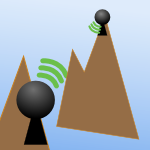1.5 mile wireless: You can do that?

So, I'm doing some network installation for a local family business. They have for years searched in vain for an affordable source of high-speed internet at their somewhat rural location. In recent years, cable and DSL have become available within a quarter mile on either side, but neither utility company has found reason to run lines to their location.
The family and small business have relied, until now, on a combination of dial-up, and 3g phone tethering, but recent business changes call for something more substantial. So they brought up long-range radio signal as a means to bring things up to speed. They found a kind neighbor, and friend, who is willing to allow internet service to be transmitted from his location, and asked me to do the research to find a way to accomplish the task.
I expected the job to be complicated and expensive, using some form of radio signal foreign to me that requires expensive hardware. In years past I worked for an IT company that had performed similar installations, and indeed they seemed to take a lot of planning and money. But, I was not involved and did not know the details of the technology.
So, I set out on my own - searching the world wild web for information on long range networking! Well, apparently I've been a bit sheltered in this area, because before long, I had found that lots of people have been using regular old 802.11 radio signals (the same kind they call WiFi) to transmit network information over longer than normal distances for years. And more recently it has only become easier and cheaper to make this technology work at home.
Some folks are making their own antennas to accomplish the task, but I'm taking the easier, faster, and probably not much more expensive route: buying a good looking product that pretty much does everything for me! I chose the AD14EX from ampedwireless.com - an outdoor directional antenna that's designed to replace your router's antenna and claims to increase range to a max of 1.5 miles when used in pairs - one AD14EX at source and one at the destination, attached to rather mundane everyday network equipment. The antennas transmit about a 30 degree spread and apparently increase signal strength by 14 DBi, but it is not clear to me whether this is just a function of focusing the signal, or if there is some sort of passive "amplification" (please share in the comments if you have insight). And, for under $100 each at newegg.com, I can't complain!
The Setup:
- Cable Internet provides high speed internet over CAT5e.
- monoprice router in gateway mode at the source.
- AD14EX attached to monoprice router at the source with separately purchased APC25EX outdoor antenna cable.
- About 1/3 mile distance with line of sight between antennas.
- At the destination, another AD14EX and APC25EX attached to a different monoprice router set as a repeater, which will provide both wireless coverage and will be wired to the main switch in a rack that will serve up network connections to all other wired clients.
The whole setup is just over $300, which is well under what I expected, not to mention way easier than I thought in terms of skill level required.
SO WILL IT WORK?
Well, I sure hope so, but stay tuned because when the installation is complete (in a few weeks?) I'll share the results here on TechThought!
Thanks for tuning in, and feel free to share your experiences in the comments section.
